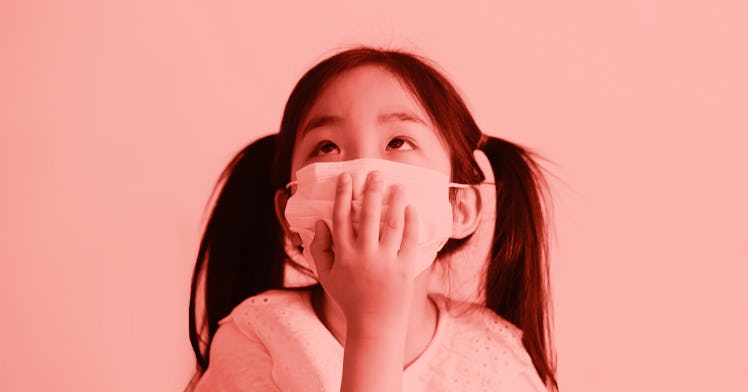Smoke Masks For Kids Aren’t As Safe As You Think
Whether you're in wildfire country or an area prone to smog, smoke masks are not going to help your kids. They're not made for them.

Walk into a hardware store in Australia and you’ll see smoke masks lining the shelves. They’ve been shipped in by the hundreds of thousands over the past few weeks to meet surging demand in the fire-choked country. The Australian government has already handed out more than three million from a national stockpile. One catch: None of these masks are meant for kids. There may be a need or even a market for children’s smoke masks, but there are no products made to truly address either.
“There is no good approach for using masks with children,” a spokesperson for the American Academy of Pediatrics told Fatherly by email. No mask certified to block small, airborne particles is made to fit a child, according to the Environmental Protection Agency.
“The reputable mask manufacturers don’t sell a child’s mask,” reiterates Brian Oliver, a professor and respiratory disease expert at the University of Technology Sydney. Other companies do sell face masks for children — Ligart’s anti-pollution mask for kids, a cartoon-cover varient on the popular N95 painter’s mask, claims to be ideal for smoke — but there’s little third-party research suggesting these products work. No children’s smoke mask has yet been certified by a government agency.
This is slightly unexpected given that the mask market is an increasingly competitive space as dust, smoke, and pollution conditions trigger air quality warnings around the world. In California, where wildfires and smog remain consisten issues, Vogmask is a rapidly expanding startup. In Asia, companies like Airpop and Respro are fighting for urban market share by offering a stylish alternative to the ubiquitous “courtesy mask.” According to a recent study by Technavio, the global gas masks market is projected to boast a compound annual growth rate of six percent in 2020, growing into a $5.75 billion market by the end of the year. Still, children, who suffer long-term adverse consequences of pollutant inhalation are being largely ignored.
Why Smoke Masks Aren’t Recommended For Children
Air filter masks aren’t designed for wildfires to begin with, explains Oliver. They’re meant to protect against particles generated from industrial sites (think: wood dust kicked up in construction) or to block the spread of infectious diseases. Fires are a different beast. They belch a motley slew of junk into the air. “We have this smorgasbord of noxious chemicals and particulates that we expect the mask to work against,” Oliver says, adding that this is unrealistic.
While masks with certifications like P2 and N95 can block some particles, they don’t filter out dangerous gases produced by fires, notably formaldehyde. Only a mask with a filtration system — what you might see a firefighter wearing — has that added layer of protection. And firefighting masks aren’t made for kids.
“If the mask is sort of floppy around your face, it just doesn’t work,” Oliver says. Masks become uncomfortable quickly if they’re fitted properly and that doesn’t mix well with kids. “Good luck getting any infant to wear anything,” Oliver says.
How To Protect Your Child From Smoke
The American Academy of Pediatrics recommends ditching a kid’s mask and staying indoors in a well-filtered building. “The best form of protection is always going to be avoidance,” agrees Oliver. “If it’s a smoky day, you don’t go for a walk in the park with your kids.”
If you do decide to buy a mask for a child, a good rule of thumb is if you can still smell smoke, the mask isn’t working properly. Masks are also most effective as single-use items, despite what advertisers might say. “It’s a little difficult to see how a mask that could be rewashed could actually be effective,” he says. After just a few hours of use, they become less efficient filters — not that they were likely efficient for children anyway.
Oliver has been in Sydney since this year’s devastating fire season began, through over a month of hazardous air quality days. He has two small children, and even though he studies respiratory diseases for a living, he hasn’t tried to buy them a mask. “I don’t know which one to buy and whether or not they’d wear it,” he says.
He’s not sold on masks already on the market. Other parents shouldn’t be either.
This article was originally published on